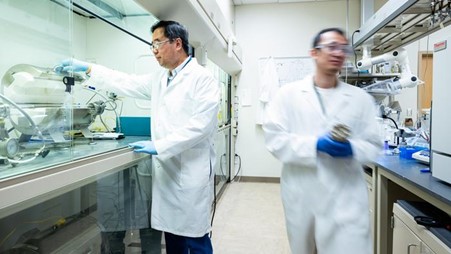Harnessing Water's Potential for Clean Fuel
An abundant source of clean energy is readily available in the form of hydrogen extracted from water (H2O) through the use of renewable energy. Researchers are actively exploring cost-effective techniques to produce clean hydrogen from water as a viable alternative to fossil fuels, as part of the global effort to address climate change. [1]

Figure 1. Di-Jia Liu inspects catalyst.
Figure 1 shows Senior chemist Di-Jia Liu inspects catalyst sample inside tube furnace after heat treatment while postdoc Chenzhao Li carries a pressure reactor for catalyst synthesis. Hydrogen has the potential to fuel vehicles without emitting any harmful substances, only releasing water as a byproduct. Moreover, it holds significant importance in various industrial sectors, particularly in the production of steel and ammonia. The adoption of cleaner hydrogen in these industries is highly desirable for promoting sustainability. [1]
“By using the cobalt-based catalyst prepared by our method, one could remove the main bottleneck of cost to producing clean hydrogen in an electrolyzer.” — Di-Jia Liu, senior chemist at Argonne. [1]
A collaborative effort involving multiple institutions, spearheaded by the U.S. Department of Energy's (DOE) Argonne National Laboratory, has successfully created an affordable catalyst for a water-based process that generates clean hydrogen. This significant achievement was made possible with the contributions of other esteemed organizations such as DOE's Sandia National Laboratories, Lawrence Berkeley National Laboratory, and Giner Inc. [1]
“A process called electrolysis produces hydrogen and oxygen from water and has been around for more than a century,” said Di-Jia Liu, senior chemist at Argonne. He also holds a joint appointment in the Pritzker School of Molecular Engineering at the University of Chicago. [1]
The emergence of Proton Exchange Membrane (PEM) electrolyzers represents a promising advancement in the field, offering a new generation of technology for the production of clean hydrogen. These electrolyzers demonstrate enhanced efficiency in splitting water into hydrogen and oxygen, even operating at near room temperature. Their reduced energy requirements make them particularly well-suited for harnessing renewable but intermittent energy sources like solar and wind power. [1]
In the case of PEM electrolyzers, separate catalysts are employed for the cathode and anode electrodes. The cathode catalyst facilitates the production of hydrogen, while the anode catalyst is responsible for generating oxygen. However, a significant challenge arises from the use of iridium in the anode catalyst, as its current market price stands at approximately $5,000 per ounce. This scarcity and high cost of iridium present a significant obstacle to the widespread adoption of PEM electrolyzers. [1]
The main ingredient in the new catalyst is cobalt, which is substantially cheaper than iridium. “We sought to develop a low-cost anode catalyst in a PEM electrolyzer that generates hydrogen at high throughput while consuming minimal energy,” Liu said. “By using the cobalt-based catalyst prepared by our method, one could remove the main bottleneck of cost to producing clean hydrogen in an electrolyzer.” [1]
Giner Inc., a prominent research and development company specializing in electrolyzers and fuel cells, conducted thorough evaluations of the new catalyst in their PEM electrolyzer test stations, operating under industrial conditions. The catalyst's performance and durability surpassed that of competing catalysts, solidifying its superiority. [1]
To further enhance the catalyst's performance, it was crucial to gain a comprehensive understanding of the atomic-scale reaction mechanism during electrolyzer operation. The team accomplished this by employing X-ray analyses at the Advanced Photon Source (APS) located at Argonne. Additionally, electron microscopy techniques at Sandia Labs and Argonne's Center for Nanoscale Materials (CNM) were utilized to identify essential catalyst features. Both the APS and CNM serve as user facilities under the DOE Office of Science. [1]
“We imaged the atomic structure on the surface of the new catalyst at various stages of preparation,” said Jianguo Wen, an Argonne materials scientist. [1]
Furthermore, computational modeling conducted at Berkeley Lab played a vital role in uncovering significant insights into the catalyst's durability during the reaction process. [1]
The team's remarkable accomplishment represents a significant stride forward in the DOE's Hydrogen Energy Earthshot initiative, inspired by the ambitious "Moon Shot" program of the 1960s. This initiative sets an ambitious target of reducing the cost of green hydrogen production to one dollar per kilogram within a decade. Achieving the production of green hydrogen at such a cost has the potential to reshape the nation's economy, with applications spanning the electric grid, manufacturing, transportation, as well as residential and commercial heating. [1]
“More generally, our results establish a promising path forward in replacing catalysts made from expensive precious metals with elements that are much less expensive and more abundant,” Liu noted. [1]
References:
- https://www.eurekalert.org/news-releases/990894
Cite this article:
Hana M (2023), Harnessing Water's Potential for Clean Fuel, AnaTechmaz, pp.447

